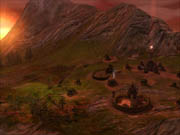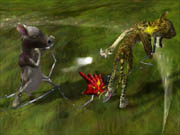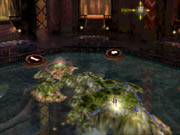After three years in the making, Lionhead Studios' first game manages to live up to the extremely high expectations after all. It's a massive game about lofty concepts--gods and miracles--and yet the game is genuinely funny. The scope of Black & White is so far in excess of a typical game design that it seems surprising that the finished product turned out so polished and so playable. Still, its many different elements require a lot of explanation--the game has lots of mainstream appeal, but its sophisticated mechanics may quickly confound more casual players. Black & White is clearly a labor of love by designer Peter Molyneux and his staff. While some aspects of it take getting used to, and can even be frustrating, there's just so much to see and experience in Black & White that its shortcomings should not turn you away from this incredible game.

Because so much about Black & White seems so unusual, it's only natural to be curious about exactly how the game plays. It's definitely true that some aspects of the game simply defy categorization--however, it's also the case that, at its core, Black & White is a strategy game that's reminiscent of several of Peter Molyneux's previous games from when he was at Bullfrog Productions. You play as a god, depicted throughout the game merely as a disembodied hand, and your object is to gain the worship of villages throughout the world. You have complete control over the 3D perspective of the game and complete control over more or less everything else in the world. You can personally see to making villagers work more efficiently. As you gain more followers, your sphere of influence grows over the land, eventually encompassing other outlying villages, which you'll have to convert to your faith. Their belief in you is quantified within the game, and the more faithful villagers you have, the greater the territory you control, and the more potential you have for creating miracles--which are essentially magic spells.

You inspire belief in villagers by doing anything godlike. This is one of the more interesting parts of the game, because it's so open-ended and really rewards your creativity. If you want to convert a village, one perfectly viable approach is to help out the villagers for a while. You can drop food and wood into the villagers' stockpile; you can shower rain onto their crops; you can impress them with miraculous spectacles, such as flocks of doves; you can protect them with magical barriers; and you can even send in friendly missionaries from one of your converted towns. If you repeat one of these types of actions continuously, it'll have less and less of an effect on the village. This forces you to try lots of different things, but of course, you don't have to play nice. A much quicker approach can involve unleashing divine cataclysms such as fireballs and lightning storms upon the town--they'll believe in you in a hurry once their precious village is ablaze. You can kidnap townspeople and bring them over to your village or fling the heathen villagers across the sky, to the terror of their former neighbors. You can even send massive boulders smashing through their buildings. An evil approach may be quicker--but then again you'll inherit a shambles of a town once it submits to you. This makes the good approach rather more suitable for when territorial gain is important, and it usually is.
Other gods in the game usually have the same goals as you do, and during those times when more than one god is vying for control of a single village, the game can actually turn into a rather frustrating stalemate, since converting a village takes awhile. And even though territorial expansion is important in Black & White, you must simultaneously consider many other factors. For one thing, while your villages are autonomous, they're not quite as self-reliant as you'd wish they were. Their supplies of wood and food--the two main resources in the game--tend to run dangerously low, as the availability of either food or wood in the environment tends to be limited. As such, you'll constantly need to be there to make the supplies appear out of thin air by casting the appropriate miracles repeatedly. Besides this, constructing new buildings in town can be a difficult process. It requires that you first build scaffolding in a workshop by assigning a few villagers to the task. Depending on the building you want to make, you'll need to combine up to seven pieces of scaffolding, and once that's ready, the building itself requires still more resources and personnel. It's a very involved process that's more cumbersome than it ought to be, especially since your townspeople won't usually build anything on their own. They'll just complain about needing more houses until you lay the foundations yourself.
There are other types of roles your villagers need to fill. By picking them up and dropping them in a context-sensitive area, you can assign them to specific tasks and thus make them your disciples. For instance, you can create a forester by placing a villager next to a tree, and you can likewise create fishermen, craftsmen, farmers, builders--even breeders, in that case by dropping the lucky citizen right next to a member of the opposite sex. Your villagers will do all these things even if you don't specifically assign them--but creating disciples costs nothing, and these types of villagers seem much more efficient. It's important not to make all of your villagers into disciples, though, because disciples are so hard at work that they typically won't pray for you at your temple (whereas regular villagers will). It's these prayers that bestow upon you prayer points and make it possible for you to cast miracles, so balancing how many disciples you have is an important strategic consideration throughout the game. Fortunately you can turn disciples back to normal villagers just by picking them up and shaking them around.

All this is meant to suggest that Black & White is by no means a simple game, nor is it easy to play. Fortunately, its lighthearted appearance--not to mention its spectacular graphics--makes it easy to get into. But actually learning all of the nuances of the core strategy game will take you awhile. Part of the problem is that the game's 50-page manual, while fairly informative, doesn't go into any depth. So for better or worse, you'll have to experiment a lot before you get a good sense of the game. Furthermore, the game is difficult to control, at least at first. The designers were determined to craft an invisible, fully mouse-driven interface for the game. This goes a long way toward making the game look better and seem that much more ambitious, but at the same time, there's a good reason why most other strategy games feature onscreen interfaces and require the use of a keyboard as well as a mouse. At any rate, camera control in Black & White, using just the mouse, is hard to grasp. You hold the left mouse button and drag the screen around to scroll. You click and hold along the edges of the map to pitch and to rotate the view. You use both mouse buttons at once to zoom in and out. You can bind all of these functions to keystrokes if you'd rather not use the mouse exclusively. Regardless, except on a very fast system, the camera control in Black & White is also rather sluggish.

The developers also came up with a very interesting concept for manipulating objects and casting miracles in the game, and it's mostly successful. You can pick up and drop pretty much anything. If you want to throw something rather than let it fall, you just flick the mouse in the desired direction before letting go of the object--rather like a game of shuffleboard. To create a miracle, you actually need to trace a particular pattern on the screen while holding down the right mouse button. These are all simple shapes, and you'll memorize them in short order. For instance, the deadly miracle called "mega blast" requires you to trace a pentagram in the air. The only problem with this system is that you may find it isn't perfectly responsive--it can take a couple of tries to get a miracle to happen, even after you've had a lot of practice. Fortunately you can also create miracles by clicking on the appropriate miracle icon along the perimeter of your village hall.
In spite of all this, most players will agree that the giant creatures are the best thing about Black & White--each god commands one as its personal avatar. You can teach the creature to mimic pretty much any of your own godly interventions. The game's sophisticated behavioral artificial intelligence makes it fascinating and very exciting to watch the creature learn any number of these things. The good news is that this aspect of the game--even though it's secondary to the core strategy game in Black & White--is even more satisfying and at least as involved. You gain your choice of creature after about a half hour of play. It starts off with the mind of a baby; it'll wander around, clueless but curious. As its curiosity inspires it to try many different things, you simply gesture with the mouse to give it positive reinforcement (by petting it lightly) or negative reinforcement (with a slap, or even a beating), depending on whether you want it to act that way again. You can guide where it moves by using one of several special leashes, which can also influence it to learn more actively, to act more kindly, or to act more aggressively. Creatures will also begin to learn miracles as you cast them in their vicinity. Soon, you can turn your giant cow (or ape, or tiger) into a farmhand by teaching it to water your crops and to toss food and wood into your stockpile. You'll also have to train it to eat a certain diet--you can pretty much convince it to try anything at least once, which can be very funny--and you'll even have to encourage it not to relieve itself on your temple.
Your own alignment in the game, which is gradually determined as you act out of good or out of evil, is totally independent of your creature's. This gives you a lot of flexibility. For instance, you can play as a purely evil god, but you can pamper your creature like a spoiled child and teach it to right all your wrongs. You can thus effectively convert a village by wreaking havoc on it yourself and then having your creature come in to relieve the damage. The bewildered villagers will soon be yours. Of course, you can also teach your creature to be hateful and violent. In either case, as you play, your creature will gradually grow larger and its appearance will also begin to shift with its moral alignment. This effect is done so subtly, and yet the result is so dramatic, that it's easily one of the more impressive aspects of the game. Your disembodied hand will also gradually change, depending on your actions.

You meet your creature in the single-player campaign, which comprises a number of different scenarios tied together by a rather mundane story about some powerful artifacts and a wicked god called Nemesis. There are a ton of optional little quests during the campaign, many of which are interesting, and like the rest of the game, these are often open-ended. Throughout the campaign, and especially early on, you'll be aided by your conscience, represented by a nasty little devil and a kindly old man. These companions help walk you through the game and offer you conflicting advice about various situations. Once you find it, your creature will follow you throughout the campaign and also into stand-alone skirmishes against the computer and even into online matches against human opponents. Creatures can even engage each other in single hand-to-hand combat in a hilarious parody of a martial arts showdown. These fight sequences look great, but they're a little hard to control, and it's too easy to fight defensively. But otherwise, since there are many different forms of animals to choose from in Black & White (though most are hidden throughout the game), a seemingly unlimited variety of ways of training your creature, and so many optional quests during the long campaign, that both the creatures and the campaign prove immensely appealing.
Most everything else about the game is equally well done. Black & White looks extremely impressive. You can zoom in to see your individual villagers' faces or zoom all the way out until your island is just a small spot in the water, and from any distance, the game looks great. There's an immense amount of detail in the graphics, and the creatures look especially good, what with their vast array of different facial expressions and other behaviors. The sound in Black & White is equally remarkable, and much like the graphics, it too features a dramatic scale of effects. You can hear villagers singing and applauding if you get right up close to them, or, high in the sky, you'll hear little save the wind. And you can hear practically everything in between as you zoom around. The voice acting in the game is great, though your advisors can begin to get repetitive after you've played awhile. Luckily you can toggle them off. The ambient music in the game shifts depending on your alignment, and it sounds very good either way and it never overwhelms the game's sound effects.

There's much more to be said about Black & White. Its multiplayer mode is interesting since you can pit your trained creatures against those of other live opponents, but the selection of maps is very limited, and the very gradual pacing of the game makes the prospect of playing through an entire multiplayer match seem intimidating. Even so, the multiplayer seems to work smoothly, and you're bound to find plenty of opponents thanks to the integrated GameSpy support in the game; and, in an amusing touch, chat messages in multiplayer actually come up in word bubbles as though your creature were doing the talking. The game has a few other gimmicks--if you register and play it while you're online, it can actually sync up the game with your local weather patterns. You can also sync it up with your e-mail (if you use Microsoft Outlook), and the villagers will take the names of contacts from your address book. Black & White is also one of the few games to support the new force-feedback mouse technology, which provides subtle tactile stimuli as you float your mouse around the game. It's not a bad effect, though it won't dramatically improve your experience with the game. Lionhead Studios also plans to support the game continuously through its Web site by offering downloadable creatures and more.
One thing is certain: Black & White is huge. It looks and sounds stunning, and its combination of gameplay elements and game mechanics is completely unique. The game can be extremely open-ended and can be extremely funny, and the better your system, the better the game will look. Some of Black & White's game mechanics aren't as enjoyable as others, and some are even rather frustrating. Furthermore, the game has a rather steep learning curve, and though it's a real-time strategy game at its core, it lacks the action-packed pacing of many other games in that genre. Even so, a direct comparison between Black & White and any other game really isn't appropriate, because the fact is that no other PC game to date has so effectively combined so many seemingly incompatible elements into one highly polished game. Black & White will continuously surprise you, and it takes a miracle for a game like that.